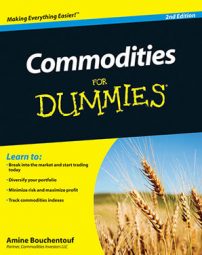Your trading account is your link to the commodity exchange. The broker’s trading platform gives you access to the exchange’s main products, such as futures contracts, options on futures, and other derivative products. Because the products traded on commodity exchanges are fairly sophisticated financial instruments, you need to specify a number of parameters to purchase the product you want.
The lifeblood of the exchange is the contract. As an investor, you can choose from a number of contracts, from plain vanilla futures contracts to exotic swaps and spreads. Whether you’re buying a forward contract or engaging in a swap, you need to follow specific entry order procedures.
Here’s a list of the parameters you need to indicate to place an order at the exchange:
Action: Indicate whether you’re buying or selling.
Quantity: Specify the number of contracts you’re interested in either buying or selling.
Time: By definition, commodity futures contracts represent an underlying commodity traded at a specific price for delivery at a specific point in the future. Futures contracts have delivery months, and you must specify the delivery month. Additionally, you need to specify the year, because many contracts represent delivery points for periods of up to five years (or more).
Commodity: This is the underlying commodity that the contract represents, such as crude oil, gold, or soybeans. Sometimes it’s also helpful to indicate the exchange on which you want to place your order.
This information is fairly significant because more of the same commodities are being offered on different exchanges. For example, the benchmark WTI crude oil, which used to be traded only on the CME/NYMEX, is now available on both the CME/NYMEX floor and the ICE electronic exchange.
Price: This info may be the most important piece of the contract: the price at which you’re willing to buy or sell the contract. Unless you’re placing a market order (which is executed at current market prices), you need to indicate the price at which you want your order to be filled.
Type of order: A lot of different types of orders exist, from plain vanilla market orders to more exotic ones such as fill or kill (FOK).This info is an important piece of the order because you’re indicating how you want to buy or sell the contract.
Day or open order: Market orders relate to price, and day or open orders relate to how long you want your order to remain open. In a day order, your order expires if it isn’t filled by the end of the trading day. An open order, however, remains open unless you cancel the order, the order is filled, or the contract expires.

